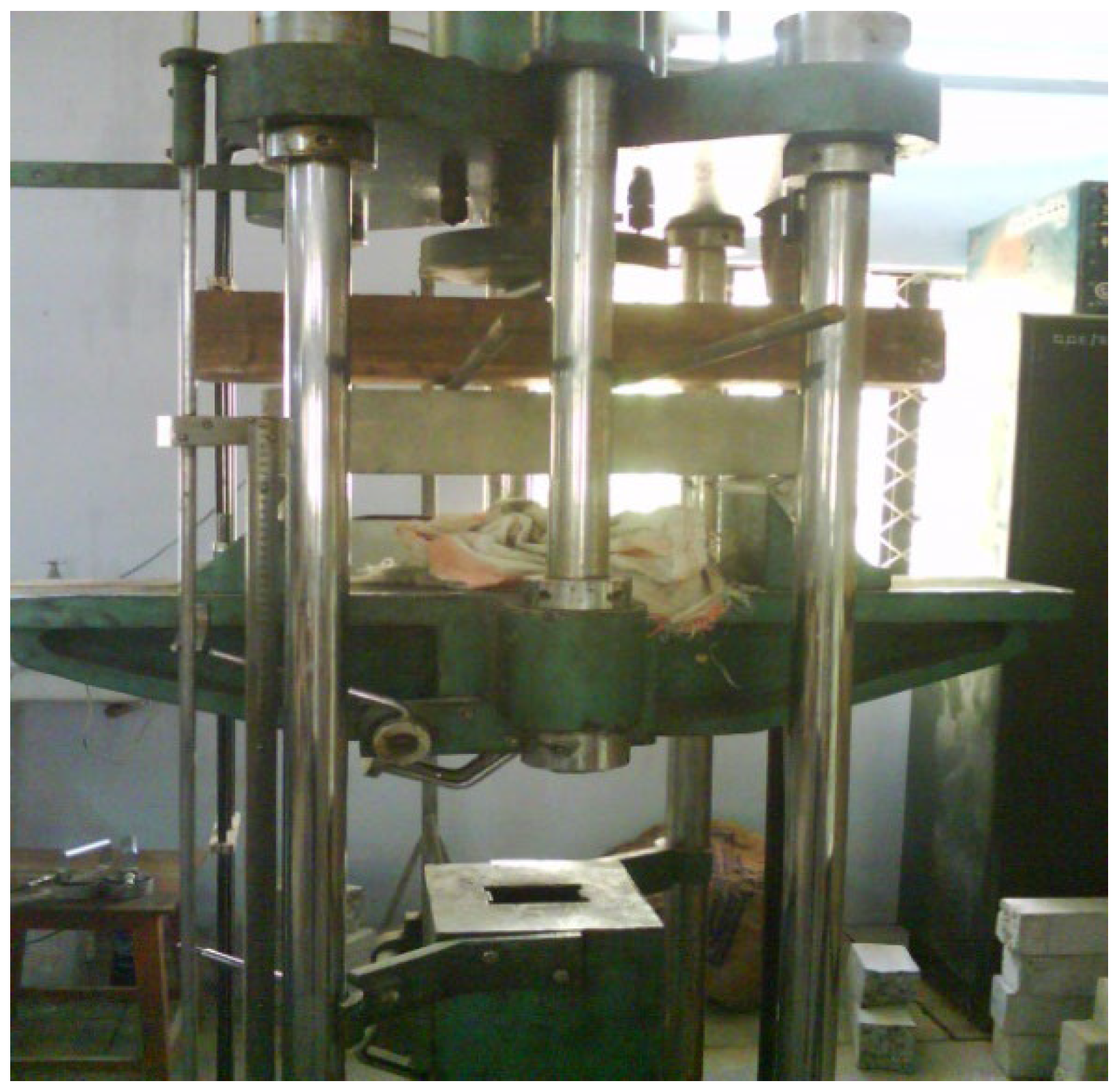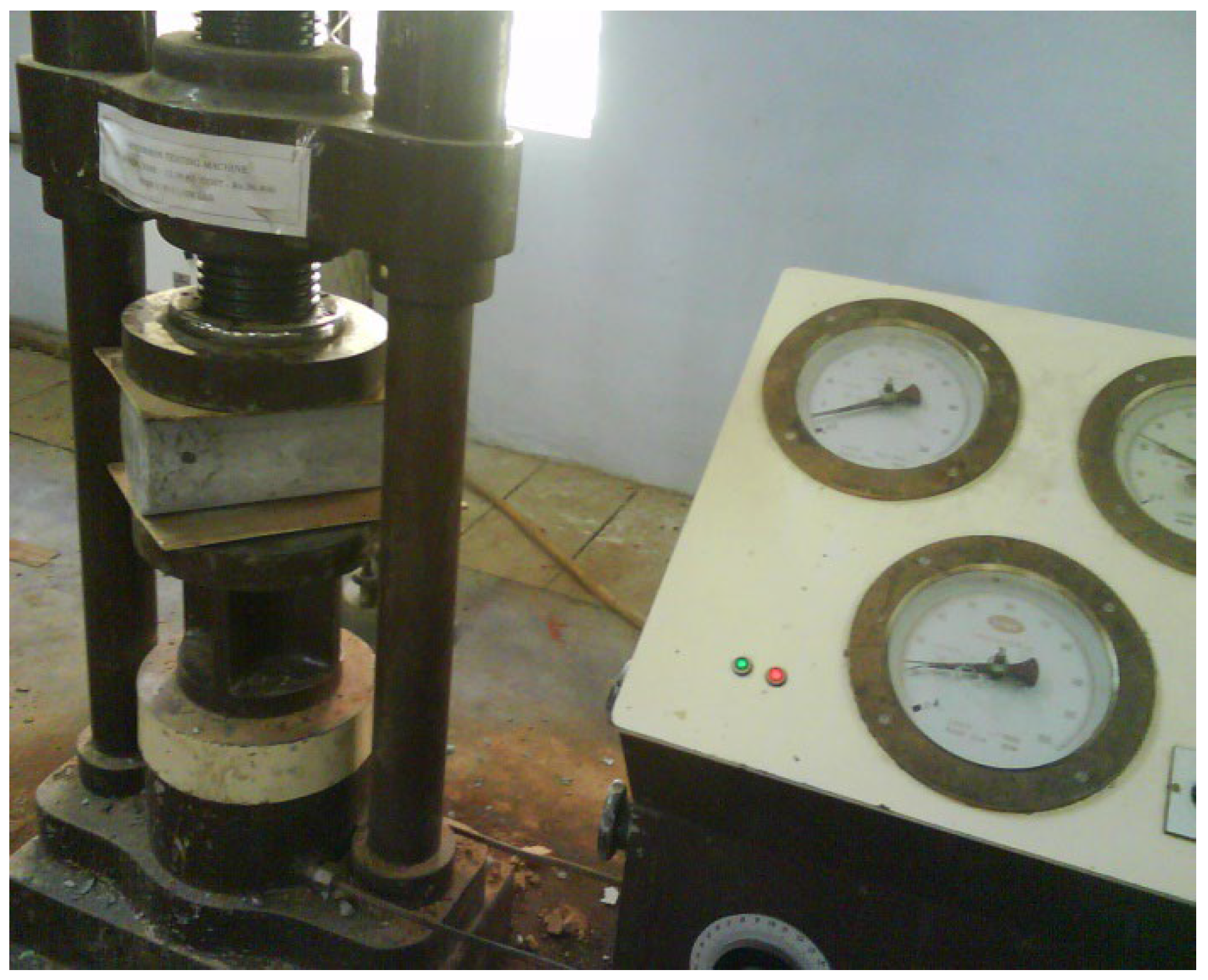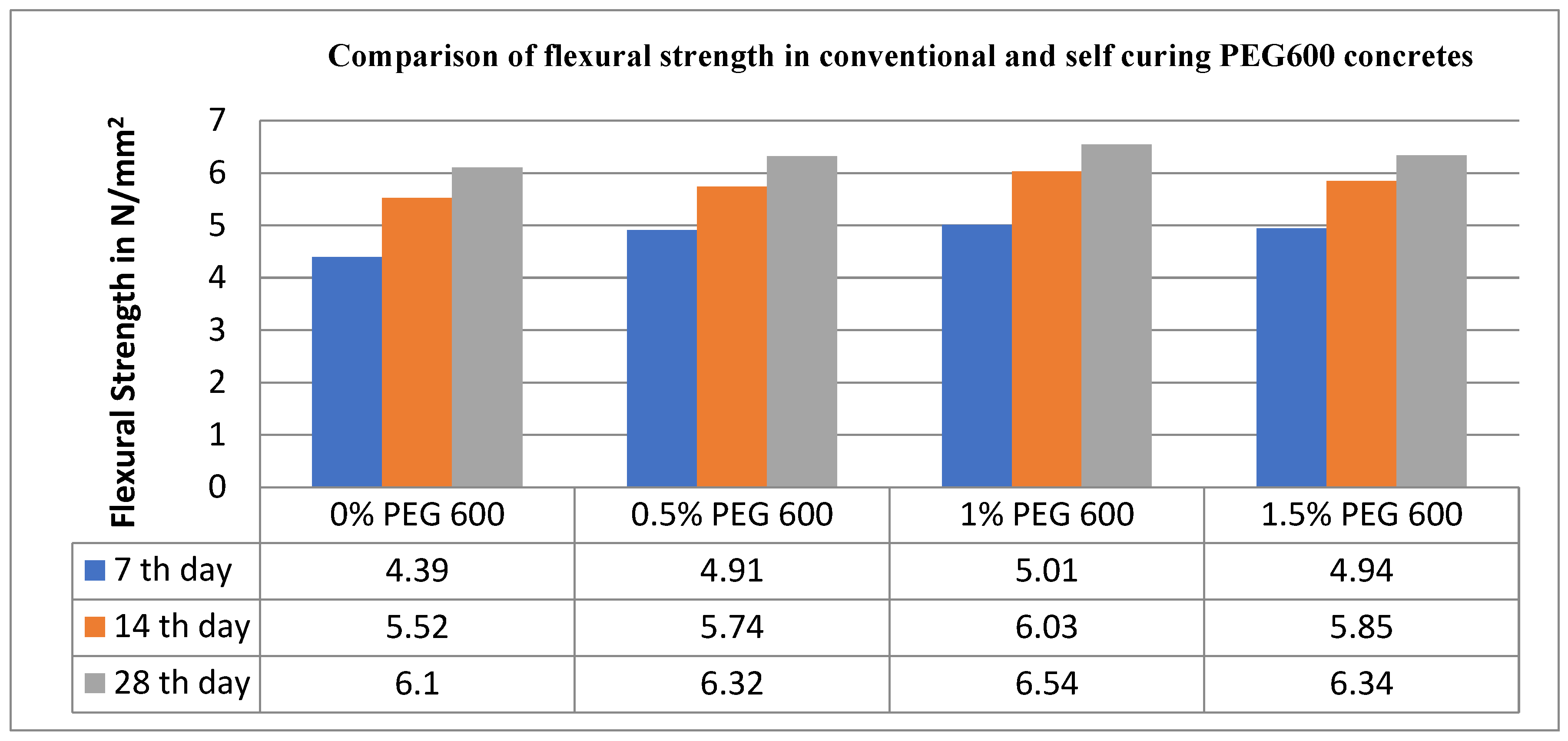Laboratory Study on the Water-Soluble Polymer as a Self-Curing Compound for Cement Concrete Roads in Ethiopia
Abstract
:1. Introduction
2. Material and Methodology
2.1. Material
2.1.1. Cement
2.1.2. Aggregates
2.1.3. Fine Aggregate
2.1.4. Potable Water
2.1.5. Polyethylene Glycol PEG-600
2.2. Mix Design
- -
- Mean design strength of concrete (fm) = fmin + K.S
- -
- Mean design strength of concrete (fm) = 40 + (1.65 × 5.6) = 49.25 N/mm2
- -
- Water cement ratio (W/C) = 0.40 non-air-entrained concrete for road pavement
- -
- Cement content (W/0.40) = (180/0.40) = 450 kg per one m3 of concrete
2.2.1. Determination of the Coarse Aggregates (C.A.)
- -
- Weight of C.A. = (0.69 × 1700) kg per one m3 of concrete
- -
- Weight of C.A. = 1173 kg per one m3 of concrete
2.2.2. Determination of the Fine Aggregates (F.A.)
2.2.3. Calculation of PEG Weights
2.2.4. Preparation of Test Specimens
Test Procedures
3. Result and Discussion
3.1. Compressive Strength
3.2. Flexural Strength
3.3. Split Tensile Test
3.3.1. Scanning Electron Microscopy (SEM) Test
3.3.2. Analysis of Cost–Benefits
4. Conclusions
Author Contributions
Funding
Institutional Review Board Statement
Informed Consent Statement
Data Availability Statement
Conflicts of Interest
References
- Economic Commission for Europe (ECE). Road Safety Performance Review Ethiopia; United Nations: New York, NY, USA, 2020; pp. 1–70. [Google Scholar]
- Chandrakasu, M.; Rajiah, M. Development of a roughness estimation model for low volume roads. Građevinar 2018, 70, 97–104. [Google Scholar] [CrossRef] [Green Version]
- Chandrakasu, M.; Rajiah, M.; Senathipathi, V.; Sekhar, C.R. Comparative Evaluation of Distress Prediction Modeling of Village Roads in India Using Regression and ANN Techniques. J. Transp. Eng. Part B Pavements 2021, 147, 04021034. [Google Scholar] [CrossRef]
- Makendran, C. Performance Modelling of Low Volume Village Roads in India. Ph.D. Thesis, Department of Civil Engineering, Anna University, Chennai, Tamil Nadu, India, 2018. Available online: http://hdl.handle.net/10603/258801 (accessed on 24 September 2019).
- Makendran, C.; Murugasan, R.; Velmurugan, S. Performance Prediction Modelling for Flexible Pavement on Low Volume Roads Using Multiple Linear Regression Analysis. J. Appl. Math. 2015, 2015, 192485. [Google Scholar] [CrossRef] [Green Version]
- Makendran, C.; Kumar, M.V.; Mahalingam, B.; Packialakshmi, S. Roughness Prediction Models Based on Variable Distress Parameters using Neural Network and MLRA for PMGSY roads. Int. J. Adv. Sci. Technol. 2020, 29, 2209–2218. [Google Scholar]
- ACI 308R-01; Guide to Curing Concrete. American Concrete Institute: Farmington Hills, MI, USA, 2008.
- Kumar, M.V.J.; Rao, K.J.; Kumar, B.D.; Reddy, V.S. Development of Self-Curing Concrete Using Polyethylene Glycol as Internal Curing Agent. Int. J. Civ. Eng. Technol. 2018, 9, 1133–1141. Available online: http://iaeme.com/Home/issue/IJCIET?Volume=9&Issue (accessed on 11 July 2018).
- Memon, R.P.; Sam, A.R.B.M.; Awang, A.Z.; Huseien, G.F.; Memon, U. A Review: Mechanism, Materials and Properties of Self-Curing Concrete. ARPN J. Eng. Appl. Sci. 2018, 13, 24. [Google Scholar]
- Cleary, J.; Delatte, N. Implementation of Internal Curing in Transportation Concrete. Transp. Res. Rec. J. Transp. Res. Board 2008, 2070, 1–7. [Google Scholar] [CrossRef]
- Lopez, M.; Kahn, L.F.; Kurtis, K.E. High-Strength self-curing low-shrinkage concrete for pavement applications. Int. J. Pavement Eng. 2010, 11, 333–342. [Google Scholar] [CrossRef]
- Eshetu, D. Urban Water Supply System Performance Assessment Case Study of Bahirdar Town, Ethiopia; Addis Ababa Science and Technology University: Addis Ababa, Ethiopia, 2015. [Google Scholar]
- Reinhardt, H.W.; Weber, S. Innovations Forum: Self-Cured High Performance Concrete. J. Mater. Civ. Eng. 1998, 10, 208–209. [Google Scholar] [CrossRef]
- Nduka, D.O.; Ameh, J.O.; Joshua, O.; Ojelabi, R. Awareness and Benefits of Self-Curing Concrete in Construction Projects: Builders and Civil Engineers Perceptions. Buildings 2018, 8, 109. [Google Scholar] [CrossRef] [Green Version]
- Dhir, R.K.; Hewlett, P.C.; Lota, J.S.; Dyer, T.D. An investigation into the feasibility of formulating ‘self-curing concrete. Mater. Struct. 1994, 27, 606–615. [Google Scholar] [CrossRef]
- Weber, S.; Reinhardt, H.W. A new generation of high performance concrete: Concrete with autogenous curing. Adv. Cem. Based Mater. 1997, 6, 59–68. [Google Scholar] [CrossRef]
- Sastry, K.V.S.G.K.; Kumar, P.M. Self-Curing concrete with different self-curing agents. IOP Conf. Ser. Mater. Sci. Eng. 2018, 330, 012120. [Google Scholar] [CrossRef]
- Udhanyan, R.; Rajamane, N.P. Experimental study of self-compacting self-curing concrete. Int. J. Civ. Eng. Technol. 2017, 8, 638–643. [Google Scholar]
- Wen-Chen, J. Method for Self-Curing Concrete. U.S. Patent US7998532B2, 24 June 2010. [Google Scholar]
- El-Dieb, A.S. Self-Curing concrete: Water retention, hydration and moisture transport. Constr. Build. Mater. 2007, 21, 1282–1287. [Google Scholar] [CrossRef]
- Naresh, T.; Harish, B.; Thirupathi, S. The study of investigation on self-curing concrete Incorporated with polyethylene glycol as self-curing agent. Int. J. Mod. Trends Eng. Res. 2017, 4, 91–95. [Google Scholar]
- Udayabanu, T.; Rajamane, N.P.; Makendran, C.; Gobinath, R.; Chary, S.C. Self-Curing Concrete Using Water-Soluble Polymer for Developing Countries. In IOP Conference Series: Materials Science and Engineering; IOP Publishing: Bristol, UK, 2020; Volume 981, p. 032088. [Google Scholar]
- ASTM C786/C786M-17; Standard Test Method for Fineness of Hydraulic Cement and Raw Materials by the 300-μm (No. 50), 150-μm (No. 100), and 75-μm (No. 200) Sieves by Wet Methods. ASTM International: West Conshohocken, PA, USA, 2017. [CrossRef]
- ASTM C187-11E1; Standard Test Method for Amount of Water Required for Normal Consistency of Hydraulic Cement Paste. ASTM International: West Conshohocken, PA, USA, 2011.
- ASTM C191-19; Standard Test Methods for Time of Setting of Hydraulic Cement by Vicat Needle. ASTM International: West Conshohocken, PA, USA, 2019. [CrossRef]
- ASTM C128-15; Standard Test Method for Relative Density (Specific Gravity) and Absorption of Fine Aggregate. ASTM International: West Conshohocken, PA, USA, 2015. [CrossRef]
- ASTM C151; Standard Test Method for Autoclave Expansion of Hydraulic Cement; Annual Book of ASTM Standards. ASTM International: West Conshohocken, PA, USA, 2009.
- ASTM C109/C109M-02; Standard Test Method for Compressive Strength of Hydraulic Cement Mortars (Using 2-in. or [50-mm] Cube Specimens). ASTM International: West Conshohocken, PA, USA, 2002.
- ASTM C136/C136M-19; Standard Test Method for Sieve Analysis of Fine and Coarse Aggregates. ASTM International: West Conshohocken, PA, USA, 2019. [CrossRef]
- ASTM 4791-10; Standard Test Method for Flat Particles, Elongated Particles or Flat Elongated Particles in Coarse Aggregates. American Society for Testing and Materials: West Conshohocken, PA, USA, 2010.
- IS:2386-4; Methods of Test for Aggregates for Concrete. Part IV Mechanical Properties. Bureau of Indian Standards: New Delhi, India, 1963.
- ASTM D5821-01; Standard Test Method for Determining the Percentage of Fractured Particles in Coarse Aggregate. ASTM International: West Conshohocken, PA, USA, 2017.
- ASTM D 3398-97; Standard Test for Index of Aggregate Particle Shape and Texture. ASTM International: West Conshohocken, PA, USA, 1997.
- ASTM C29/C29M-17a; Standard Test Method for Bulk Density (“Unit Weight”) and Voids in Aggregate. ASTM International: West Conshohocken, PA, USA, 2017. [CrossRef]
- ASTM C1252-17; Standard Test Methods for uncompact Void Content of Fine Aggregate (as Influenced by Particle Shape, Surface Texture, and Grading). ASTM International: West Conshohocken, PA, USA, 2017. [CrossRef]
- ASTM C127-15; Standard Test Method for Relative Density (Specific Gravity) and Absorption of Coarse Aggregate. ASTM International: West Conshohocken, PA, USA, 2015. [CrossRef]
- Kumar, M.V.; Lemessa, K. Behavior of Concrete with Agro and Industry Waste as a Replacement for Constitutive Materials. Am. J. Eng. Res. 2017, 6, 79–85. [Google Scholar]
- ASTM E2542-08; Standard Specification for Portable Water Heaters Used at Personnel Decontamination Stations. ASTM International: West Conshohocken, PA, USA, 2014. [CrossRef]
- ACI 211.1-91; Standard Practice for Selecting Proportions for Normal, Heavyweight, and Mass Concrete (ACI 211.1-91) as Found in Their ACI Manual of Concrete Practice 2000; Part 1: Materials and General Properties of Concrete. The American Concrete Institute (ACI): Farmington Hills, MI, USA, 2000.
- Balaguru, S.; Shashi, K.; Vela, M.; Chellapandi, P. Thermo Mechanical Analysis of SS304 Circular Grid Plate Hard-faced with Colmonoy. Appl. Mech. Mater. 2012, 229–231, 710–717, ISSN: 1662-7482. [Google Scholar] [CrossRef]
- ACI 308-213; Report on Internally Cured Concrete Using Prewetted Absorptive Lightweight Aggregate (ACI 308-213 R-13). American Concrete Institute: Farmington Hills, MI, USA, 2013.







| No. | Name of the Test | Result Obtained | Remarks/Standards |
|---|---|---|---|
| 1 | Fineness range of cement | 1.5–10 microns | Acceptable as per ASTM C786 17 standards [23] |
| 2 | Normal consistency | 31% | ASTM C187-11E1 [24] |
| 3 | Initial and final setting time of cement | 27 min and 8 h | Acceptable as per ASTM C-191 standards [25]. |
| 4 | Specific gravity (Sp.gr) | 3.15 | Acceptable as per ASTM C128-15 [26]. |
| 5 | Soundness | 3 mm | ASTM C151 [27] |
| 6 | Compressive strength | 43 N/mm2 | ASTM C109/C109M-02 [28] |
| No. | Properties of Aggregate | Fine Aggregate | Coarse Aggregate | Test Followed |
|---|---|---|---|---|
| 1 | Average flakiness ratio | 0.62 | ||
| 2 | Flakiness index | 7.3% | ||
| 3 | Elongation index | 12% | ||
| 4 | Elongation ratio | 1.3 | ASTM 4791-10 [30] | |
| 5 | Impact value | 12% | ||
| 6 | Crushing value | 16% | IS: 2386 (Part IV)–1963 [31] | |
| 7 | Sphericity | 0.65 | ASTM D5821-01, 2017 [32] | |
| 8 | Shape factor | 0.64 | ASTM D 3398-97 [33] | |
| 9 | Bulk density | 1618 kg/m3 | 1625 kg/m3 | ASTM C29 / C29M-17a [34] ASTM C1252-17 [35] |
| 10 | Water absorption test | 1.35% | 2.0% | ASTM C127–15 [36] |
| 11 | Specific gravity | 2.625 | 2.710 | ASTM C127–15 [36] |
| No. | Properties of PEG-600 | Result |
|---|---|---|
| 1 | Molecular weight | 570–630 g/mol. |
| 2 | Color | Clear Fluid |
| 3 | Hydroxyl value, mg KOH/g | 178.0–197.0 |
| 4 | Density | 1.13 kg/cm3 |
| 5 | Water (Karl Fischer) | 0.5% max |
| 6 | pH at 5% | 4.5–7.5 |
| 7 | Solubility | Soluble in water |
| 8 | Free EO (ethylene oxide), | 10.0 ppm max. |
| 9 | Specific gravity | 1.12 |
| 10 | Ethylene glycol and diethylene glycol | 0.2% max |
| 11 | Odor | Mild odor |
| 12 | Viscosity @ 20 °F | 9.9–11.3 |
| 13 | Flashpoint | 4 °C to 8 °C |
| 14 | Heavy metals | 5 ppm. |
| 15 | Dioxane 1,4 | 10.0 ppm. |
| 16 | Molecular weight | 570–630 g/mol |
| 17 | Ash | 0.1% max |
| Test | Values | Standards |
|---|---|---|
| Maximum size of aggregate | 25 mm | ACI 211.1-91 [39] |
| Slump | 50 mm, 25 mm | ACI 211.1-91 [39] |
| Water content | 180 kg/m3 | ACI 308R-01 [7] |
| Air content | 1.5% | ACI 308R-01 [7] |
| Materials | Unit | Quantity | Cement Concrete Ratio |
|---|---|---|---|
| Cement | kg | 450 | 1.0 |
| Fine Aggregate | kg | 590 | 1.31 |
| Coarse Aggregate | kg | 1173 | 2.60 |
| Water | Liters | 180 | 0.40 |
| % of PEG | Cement in (kg/m3) | Weight of PEG in (kg/m3) | Total Wt. of Concrete in (kg/m3) (Cement + PEG + F.A. + C.A. + Water) |
|---|---|---|---|
| 0% | 450 | 0.00 | 450 + 0.00 + 590 + 1173 + 180 = 2393.00 |
| 0.5 | 450 | 2.25 | 450 + 2.25 + 590 + 1173 + 180 = 2395.25 |
| 1.0 | 450 | 4.5 | 450 + 4.50 + 590 + 1173 + 180 = 2397.50 |
| 1.5 | 450 | 6.75 | 450 + 6.75 + 590 + 1173 + 180 = 2399.75 |
| Test | Conventional Concrete | Self-Curing PEG-600 Concrete | ||
|---|---|---|---|---|
| Workability M40 | Without PEG- 600 | PEG-600: 0.5% | PEG-600: 1% | PEG-600: 1.5% |
| Slump in (mm) | 62 | 78 | 99 | 121 |
| Compaction factor | 0.83 | 0.86 | 0.89 | 0.92 |
| Type of Concrete | Water Required for Curing Process of 1 m3 Concrete | Cost of Water Per Liter (ETB) | Labor Cost for Conventional Curing Process of 1 m3 (Number of Laborers × Labor Cost Per Day) (C = Labor Cost) or Self-Curing Polyethylene Glycol (PEG-600) Concrete-(Number of Liters × Cost) (C = Cost of PEG-600/L) | The Total Cost Required for 1 m3 of Concrete (ETB) |
|---|---|---|---|---|
| (A = Liters of water) | (B = Cost of water/liter) | (C = Labor cost) | X = (A × B) + (C) | |
| Conventional concrete | 3000 | 0.60 | 5 × 350 | 1800 + 1750 = 2850 |
| Self-curing Polyethylene Glycol (PEG 600) concrete | 180 | 0.60 | 3.20 × 500 | 108 + 1600 = 1708 |
| The Cost saved by using self-curing PEG 600 for 1 m3 of concrete (ETB) = 1142 | ||||
Publisher’s Note: MDPI stays neutral with regard to jurisdictional claims in published maps and institutional affiliations. |
© 2022 by the authors. Licensee MDPI, Basel, Switzerland. This article is an open access article distributed under the terms and conditions of the Creative Commons Attribution (CC BY) license (https://creativecommons.org/licenses/by/4.0/).
Share and Cite
Chandrakasu, M.; Suthandhiram, K.; Garoma, S.; Merea, B.; Sethuraman, B. Laboratory Study on the Water-Soluble Polymer as a Self-Curing Compound for Cement Concrete Roads in Ethiopia. Technologies 2022, 10, 80. https://doi.org/10.3390/technologies10040080
Chandrakasu M, Suthandhiram K, Garoma S, Merea B, Sethuraman B. Laboratory Study on the Water-Soluble Polymer as a Self-Curing Compound for Cement Concrete Roads in Ethiopia. Technologies. 2022; 10(4):80. https://doi.org/10.3390/technologies10040080
Chicago/Turabian StyleChandrakasu, Makendran, Karunanidhi Suthandhiram, Shiferaw Garoma, Bekesha Merea, and Balaguru Sethuraman. 2022. "Laboratory Study on the Water-Soluble Polymer as a Self-Curing Compound for Cement Concrete Roads in Ethiopia" Technologies 10, no. 4: 80. https://doi.org/10.3390/technologies10040080
APA StyleChandrakasu, M., Suthandhiram, K., Garoma, S., Merea, B., & Sethuraman, B. (2022). Laboratory Study on the Water-Soluble Polymer as a Self-Curing Compound for Cement Concrete Roads in Ethiopia. Technologies, 10(4), 80. https://doi.org/10.3390/technologies10040080







